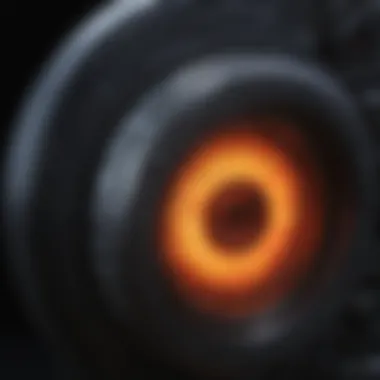Unveiling the Enigmatic World of Ultraviolet Flashlights


Types and Functions of UV Flashlights
In the realm of UV flashlights, it is crucial to discern the different types available. These encompass UV-A, UV-B, and UV-C, each possessing unique emission wavelengths and applications. UV-A flashlights, emitting long-wave ultraviolet light, find utility in mineral detection, forensics, and leak detection. Conversely, UV-B flashlights offer medium-wave ultraviolet light, ideal for medical diagnostic assessments and certain industrial processes. UV-C flashlights, emitting short-wave ultraviolet light, are predominantly utilized for germicidal applications.
While exploring the functionalities of UV flashlights, it is essential to comprehend their distinct features. These flashlights are designed to emit ultraviolet light invisible to the human eye but crucial for numerous applications such as fluorescence detection, counterfeit bill verification, and even pet stain detection. The compact designs and diverse forms factor further enhance their versatility for applications ranging from outdoor adventures to scientific research.
Applications Across Diverse Fields
The applications of UV flashlights span across a wide array of fields, showcasing their versatility and indispensability. In forensic science, UV flashlights are employed for crime scene investigations, revealing bodily fluids and forensic evidence invisible under normal light. Adversely, in the realm of medicine, UV flashlights aid in the diagnosis and treatment of certain skin conditions by detecting fluorescent signals emitted by affected areas.
Furthermore, UV flashlights find extensive utility in mineralogy and gemology, enabling enthusiasts and professionals alike to distinguish luminescent specimens and evaluate mineral compositions effectively. The applications expand to sanitation, where UV-C flashlights are utilized for disinfection purposes, safeguarding against harmful pathogens in various environments.
Benefits and Considerations
An overview of the benefits and considerations associated with UV flashlights illuminates their value proposition and operational nuances. One primary advantage is their portability and ease of use, allowing for convenient utilization in diverse settings without reliance on external power sources. The non-invasive nature of UV radiation emitted by these flashlights ensures minimal impact on users and objects under scrutiny, facilitating precise applications in sensitive scenarios.
However, it is imperative to exercise caution while operating UV flashlights, as prolonged exposure to UV radiation can have adverse effects on human health. Protective eyewear and adherence to usage guidelines are critical to mitigating potential risks. Additionally, the selection of appropriate UV flashlight types based on intended applications is pivotal for achieving optimum results and ensuring operational efficiency.
Synthesizing Insights and Future Prospects
As we delve deeper into the realm of UV flashlights, synthesizing insights garnered thus far paves the way for discerning future prospects and advancements in UV technology. The evolution of UV flashlight designs, with enhanced durability and energy efficiency, promises continued innovation and expanded applications across industries.
Looking ahead, the integration of UV technology into diverse fields holds promising possibilities, ranging from medical diagnostics to environmental monitoring. By staying attuned to emerging trends and optimizing UV flashlight functionalities, enthusiasts and professionals can harness the full potential of this advanced technology, shaping new frontiers in illumination and detection capabilities.
Introduction to UV Flashlights
UV flashlights are an essential tool in various industries and applications due to their unique ability to emit ultraviolet light. These specialized flashlights offer a wide range of functionalities and benefits that set them apart from traditional light sources. Understanding the intricacies of UV light and its applications can provide valuable insights into the captivating world of UV flashlights.
Understanding Ultraviolet Light
UV Spectrum Overview
UV Spectrum Overview: Shedding light on the UV spectrum is crucial to grasping the essence of UV flashlights. The UV spectrum consists of different wavelengths ranging from UV-A, UV-B, to UV-C, each with distinct properties and uses. This overview serves as a foundation for comprehending how UV light operates and its significance in the realm of UV flashlights.
Properties of UV Light: Delving into the properties of UV light offers a deeper understanding of its behavior and effects. UV light possesses unique qualities such as fluorescence and germicidal properties, making it a versatile tool in various applications. Understanding these properties is essential to harnessing the full potential of UV light within UV flashlights.
What is a UV Flashlight?
Key Components


Key Components: Exploring the key components of UV flashlights reveals the intricate engineering behind these devices. Components such as UV bulbs, reflectors, and power sources play a vital role in the functionality of UV flashlights. Understanding the significance of each component elucidates how UV flashlights achieve their distinctive performance.
Types of UV Flashlights: Diving into the different types of UV flashlights unveils a diverse array of options available in the market. From handheld to portable UV flashlights, each type caters to specific needs and preferences. Evaluating the pros and cons of each type assists users in selecting the most suitable UV flashlight for their requirements.
Importance of UV Light in Flashlights
Applications in Various Fields
Applications in Various Fields: UV light finds extensive utilization across various industries, including forensic science, mineralogy, and pet stain detection. Its ability to reveal hidden patterns, detect microbial contamination, and identify fluorescent minerals underscores its significance in diverse fields. Exploring these applications sheds light on the indispensable role of UV light in flashlight technology.
Benefits of UV Flashlights: Unveiling the benefits of UV flashlights showcases their unmatched advantages over conventional lighting sources. From their energy efficiency to their ability to detect hidden stains and contaminants, UV flashlights offer a myriad of benefits. Understanding these benefits highlights the practicality and efficiency of integrating UV light into flashlight design.
Features and Characteristics of UV Flashlights
In this section, we delve into the pivotal aspects of UV flashlights, shedding light on their crucial features and characteristics that set them apart. Understanding the intricacies of these UV devices is essential in comprehending their utility across various industries. When exploring UV flashlights, one key element to consider is the wavelength and intensity of the emitted ultraviolet light. The UV spectrum is divided into different segments - UV-A, UV-B, and UV-C - each with unique properties and applications. UV-A light, with longer wavelengths, is commonly used in fluorescent minerals identification, revealing intricate details that are not visible to the naked eye. UV-B light, with medium wavelengths, finds its use in applications like document verification and forensic studies. On the other hand, UV-C light, with shorter wavelengths, is effective in sterilization processes due to its ability to destroy germs and viruses. Each segment of the UV spectrum offers distinct advantages and considerations, making it essential for users to select the appropriate wavelength based on their intended purpose.
When discussing the output power of UV flashlights, it is imperative to understand how the intensity of the emitted light impacts their functionality. High output power UV flashlights provide brighter light, allowing for enhanced visibility of fluorescent substances or materials under ultraviolet radiation. However, one must also consider that higher output power may lead to increased energy consumption and heat generation, affecting the device's operational efficiency. Balancing output power with energy conservation is crucial in choosing the right UV flashlight for specific applications. Therefore, users need to evaluate their requirements carefully and select a flashlight with an output power that aligns with their intended use, ensuring optimal performance and longevity.
Moving on to the design and durability of UV flashlights, the materials used in their construction play a significant role in their effectiveness and longevity. High-quality materials such as aluminum or stainless steel enhance the durability of UV flashlights, making them resilient against impacts and environmental factors. Additionally, water and impact resistance are critical features that determine the reliability of UV flashlights in various working conditions. Flashlights with robust water-resistance properties maintain their functionality even in damp or wet environments, making them suitable for outdoor use or forensic investigations where exposure to moisture is common. Likewise, impact-resistant UV flashlights can withstand accidental drops or rough handling, ensuring their longevity and consistent performance in demanding scenarios. The choice of materials and the level of water and impact resistance are key considerations in selecting a durable and reliable UV flashlight for long-term usage.
In terms of size and portability, UV flashlights come in various models ranging from compact designs to full-size options. Compact UV flashlights offer the advantage of easy storage and carrying convenience, making them ideal for on-the-go use or fieldwork where lightweight equipment is preferred. Full-size UV flashlights, while bulkier, provide longer operating times and may offer enhanced features such as adjustable beam settings or extended battery life. Users must account for the trade-off between size and functionality when choosing between compact and full-size models based on their specific requirements. Furthermore, assessing the ease of carrying a UV flashlight is essential for user comfort and operational efficiency. Factors such as grip ergonomics, weight distribution, and integrated carrying options influence the practicality of the flashlight in different usage scenarios. By evaluating the size and portability aspects of UV flashlights, users can make informed decisions that align with their usability needs and preferences.
Wavelength and Intensity
UV-A, UV-B, and UV-C
When exploring the variations in the UV spectrum, understanding the distinct properties of UV-A, UV-B, and UV-C is crucial for optimizing the performance of UV flashlights. UV-A light, characterized by longer wavelengths between 315 and 400 nanometers, is commonly used in applications requiring the detection of fluorescent substances such as minerals or organic compounds. Its ability to induce fluorescence in certain materials makes UV-A an essential tool in mineralogy, forensics, and counterfeit detection. UV-B light, with wavelengths ranging from 280 to 315 nanometers, possesses moderate penetration capabilities, making it suitable for sterilization, germicidal applications, or curing processes in industries like healthcare and manufacturing. UV-C light, with the shortest wavelengths between 100 and 280 nanometers, exhibits strong germicidal properties capable of deactivating bacteria, viruses, and other microorganisms on surfaces or in the air. The targeted use of UV wavelengths ensures precise results in diverse applications, showcasing the adaptability and effectiveness of UV flashlights in specialized tasks.
Output Power
Examining the output power of UV flashlights provides insight into the intensity of ultraviolet radiation emitted by these devices. High output power UV flashlights generate a more substantial amount of UV light, resulting in brighter fluorescence or more effective sterilization compared to lower output models. However, higher output power necessitates more energy consumption and may lead to increased heat production, affecting the operating temperature of the flashlight. Users must balance the need for high intensity with practical considerations such as battery life, heat management, and device size to optimize the performance of UV flashlights in their specific applications. Lower output power UV flashlights offer energy-efficient options suitable for tasks that require moderate UV exposure without excessive heat generation, catering to users seeking a balance between performance and battery longevity. By evaluating the output power of UV flashlights, users can select devices that align with their desired UV intensity levels, ensuring optimal results in diverse tasks.
Design and Durability
Materials Used
The choice of materials in UV flashlight construction significantly impacts their durability, performance, and overall reliability. Utilizing high-quality materials such as aircraft-grade aluminum or stainless steel enhances the structural integrity of UV flashlights, making them resistant to physical impacts, corrosion, and wear over time. Aluminum alloy bodies offer a lightweight yet sturdy design, ideal for users seeking a balance between durability and portability in their UV illumination devices. Stainless steel components provide added resilience against harsh conditions, ensuring the longevity and consistent performance of UV flashlights in demanding environments. The selection of materials in UV flashlight manufacturing reflects a commitment to quality, functionality, and user satisfaction, emphasizing the importance of durable construction in modern lighting solutions.
Water and Impact Resistance


When considering the robustness of UV flashlights, factors such as water and impact resistance play a crucial role in determining their suitability for diverse applications. Flashlights with IPX waterproof ratings demonstrate the ability to withstand exposure to moisture, rain, or immersion in water up to specific depths without compromising their functionality. This feature is particularly valuable in outdoor settings, forensic investigations, or underwater exploration where reliable illumination is essential. Additionally, UV flashlights with high impact resistance can endure accidental drops, rough handling, or challenging working conditions without sustaining damage to their internal components or light output. The combination of water resistance and impact resistance ensures the durability and reliability of UV flashlights in various professional settings, providing users with peace of mind and long-lasting performance in critical scenarios.
Size and Portability
Compact vs. Full-Size Models
The distinction between compact and full-size UV flashlights offers users the flexibility to choose devices that align with their priorities in terms of size, weight, and operational features. Compact UV flashlights prioritize portability and ease of handling, making them ideal for users who require lightweight illumination tools for on-the-go tasks or fieldwork. Their smaller form factor allows for convenient storage in pockets, gear bags, or toolkits, ensuring accessibility and readiness whenever UV illumination is needed. In contrast, full-size UV flashlights cater to users seeking extended operating times, robust construction, and advanced functionalities such as adjustable beam settings or multiple light modes. While larger in size and weight, full-size models offer enhanced performance capabilities suitable for professional use in disciplines like law enforcement, industrial inspections, or scientific research. Users must evaluate their specific requirements and preferences to determine whether a compact or full-size UV flashlight best suits their intended applications, balancing portability with functionality to achieve optimal results.
Ease of Carrying
The practicality of carrying a UV flashlight is essential for ensuring user convenience, ergonomic comfort, and operational efficiency in various settings. Factors influencing the ease of carrying include the flashlight's weight distribution, grip ergonomics, attachment options, and portability features tailored to user preferences and operational needs. Lightweight and compact UV flashlights designed with ergonomic grips offer users a comfortable and secure hold during extended use, minimizing hand fatigue and improving maneuverability in different lighting tasks. Integrated features like belt clips, lanyard attachments, or magnetic mounts enhance the accessibility and hands-free operation of UV flashlights, allowing users to carry or deploy the flashlight conveniently in various work environments. By evaluating the ease of carrying UV flashlights, users can optimize their lighting experiences, enhance task performance, and streamline workflow efficiency through ergonomic design and functional mobility solutions.
Applications Across Various Industries
The spectrum of ultraviolet (UV) light opens up a plethora of applications across various industries, making UV flashlights indispensable tools in diverse fields. From forensic science to mineralogy and geology, as well as pet stain detection and cleaning, the versatility of UV technology knows no bounds. Delving deep into the unique characteristics and benefits of UV light in different sectors sheds light on its multifaceted nature.
Forensic Science and Detection
Crime Scene Investigation
Crime Scene Investigation (CSI) stands out as a vital application of UV flashlights in forensic science. The ability to detect bodily fluids, fibers, and other trace evidence invisible to the naked eye under UV light enhances the efficiency and accuracy of crime scene analysis. Through the unique capability of CSI to reveal hidden clues and markers crucial for investigations, it plays a pivotal role in unraveling complex cases and solving crimes effectively. The distinctive feature of CSI lies in its ability to illuminate substances that conventional lights cannot, providing forensic experts with invaluable insights into crime scenes and aiding in evidence collection.
Forgery Detection
Forgery Detection utilizes UV flashlights to scrutinize documents, currencies, and sensitive materials for authenticity. By employing UV light to reveal invisible inks, security features, or alterations not visible under normal light, this technique ensures the validation of legal documents and currencies. The key advantage of Forgery Detection lies in its non-destructive nature, allowing for thorough inspection without causing harm to the examined materials. The unique feature of this application lies in its ability to uncover subtle discrepancies that could indicate potential fraud, safeguarding industries and individuals from counterfeit activities.
Mineralogy and Geology
Fluorescent Mineral Identification
Fluorescent Mineral Identification relies on UV illumination to distinguish fluorescing minerals from non-fluorescing ones based on their distinct colorations. This method aids mineralogists in identifying specific mineral species and geological formations with enhanced precision. The key characteristic of Fluorescent Mineral Identification is its ability to differentiate minerals that share similar visual appearances under normal light, facilitating accurate classification and analysis. The unique feature of this technique is its capacity to unveil mineral compositions that may remain concealed without UV exposure, thereby broadening the spectrum of mineralogical research and exploration.
Exploration of Geological Formations
Exploration of Geological Formations harnesses UV light to unveil hidden patterns, mineral contents, and structural details within geological samples or formations. By illuminating geological surfaces with UV rays, geologists can discern subtle variations in mineralogical compositions and structural anomalies that may not be apparent under natural lighting conditions. The critical advantage of this exploration method lies in its ability to highlight specific geological features for in-depth study and analysis. The unique feature of exploring geological formations with UV light is its capacity to unveil intricate details vital for geological mapping and resource assessment, promoting comprehensive understanding and interpretation of Earth's geological history.
Pet Stain Detection and Cleaning
Identification of Biological Residues


Identification of Biological Residues utilizes UV light to detect hidden stains, bodily fluids, or organic residues on surfaces, aiding in the identification and remediation of pet-related messes. This technique is invaluable for pet owners seeking to maintain cleanliness and hygiene in their living spaces. The key characteristic of this method is its efficiency in revealing invisible stains or residues left behind by pets, guiding effective cleaning measures. The unique feature of identifying biological residues with UV light is its ability to pinpoint specific areas requiring attention, facilitating targeted cleaning and odor removal.
Effective Cleaning Techniques
Effective Cleaning Techniques leverage UV light to validate the thoroughness of cleaning efforts by verifying the removal of biological residues and stains post-cleaning. By illuminating cleaned surfaces with UV light, individuals can verify the effectiveness of their cleaning methods and ensure a hygienic environment. The significant advantage of this technique lies in its ability to provide visual confirmation of cleanliness, promoting hygiene standards and allergen reduction. The unique feature of employing UV light for cleaning verification is its capacity to detect residual contaminants invisible to the naked eye, promoting enhanced cleaning precision and sanitation practices.
Choosing the Right UV Flashlight
When delving into the world of UV flashlights, selecting the right one is crucial for optimal performance and desired outcomes. Understanding the specific elements that make up a UV flashlight and considering various factors can lead to a more informed decision. This section aims to guide readers through the process of choosing the most suitable UV flashlight according to their needs and preferences.
Factors to Consider
Intended Use
Intended use plays a pivotal role in selecting the appropriate UV flashlight. Whether it is for professional use in forensic investigations, amateur applications like rock and fossil collection, or personal use for detecting pet stains, understanding the intended purpose helps in narrowing down the options. The key characteristic of matching the UV flashlight's features with the intended application ensures optimal performance. For instance, a rock and fossil collector might require a UV flashlight with specific wavelength capabilities to enhance fluorescence in minerals, making it a popular choice for enthusiasts in this field. Despite its advantages, such targeted functionality may limit its versatility in other applications.
Budget Considerations
Budget considerations are another essential aspect when choosing a UV flashlight. Setting a budget helps in filtering out options that may exceed financial limits while still meeting the desired criteria. Different UV flashlights come at varying price points, with higher costs often correlating with advanced features or durability. Understanding the unique features related to different price ranges allows users to make a cost-effective decision. While a higher-priced model may offer additional benefits like longer battery life or increased durability, a budget-friendly option could adequately fulfill basic UV lighting needs without compromising quality, making it a suitable choice for budget-conscious consumers.
Popular Brands and Models
Top Picks in the Market
Exploring the top picks in the market enables consumers to learn about leading UV flashlight brands and models distinguished by their quality and performance. Top picks often stand out for their superior build quality, reliable output power, and ergonomic design, making them popular choices among users with diverse needs. Understanding the key characteristics of these top picks, such as enhanced wavelength precision or robust construction, provides insights into their advantages over competitors. While these models may come at a premium price, their unmatched features and durable build make them worthwhile investments for those seeking long-term UV lighting solutions.
User Reviews and Recommendations
User reviews and recommendations offer valuable insights derived from firsthand experiences with different UV flashlight models. Considering user feedback helps potential buyers gauge the performance, durability, and usability of various products before making a purchase. Highlighting key characteristics based on user reviews, such as ergonomic grip, intuitive controls, or extended battery life, influences decision-making by emphasizing practical advantages. User recommendations based on specific needs, such as hobbyist mineral collectors endorsing a particular model for its optimal fluorescence enhancement, guide prospective buyers in choosing a UV flashlight that aligns with their requirements. Incorporating user perspectives and recommendations ensures an informed selection tailored to individual preferences and priorities.
Safety Measures and Best Practices
Safety measures and best practices are crucial aspects to consider when delving into the intriguing world of UV flashlights. Understanding how to effectively handle UV light can significantly impact one's safety and the lifespan of the flashlight. By adhering to proper safety protocols, users can maximize the utility of their UV flashlight while minimizing potential risks associated with UV exposure.
UV Exposure Guidelines
Protective Eyewear
Protective eyewear plays a pivotal role in safeguarding users against harmful UV rays emitted by UV flashlights. The unique design of protective eyewear shields the eyes from direct UV exposure, reducing the risk of eye damage or discomfort. Opting for high-quality protective eyewear with UV protection coatings can enhance user safety and comfort during flashlight operation. While protective eyewear may impede vision clarity slightly, the benefits of eye protection far outweigh any minor visual hindrances, making it an indispensable accessory for utilizing UV flashlights effectively.
Avoiding Direct Skin Contact
Avoiding direct skin contact with UV light is another key aspect of ensuring user safety when using a UV flashlight. Direct skin exposure to UV rays can lead to skin irritations, burns, or long-term damage. By maintaining a safe distance from the UV light source and using protective clothing to shield the skin, individuals can mitigate the potential risks associated with UV exposure. Practicing caution and mindfulness when handling UV flashlights, especially in prolonged usage scenarios, is paramount to safeguarding skin health and well-being.
Proper Handling and Storage
Proper handling and storage practices are essential for preserving the functionality and longevity of UV flashlights. By adhering to recommended temperature considerations, users can prevent overheating or internal damage to the flashlight components. Storing UV flashlights in cool, dry environments away from direct sunlight can prolong their lifespan and maintain optimal performance levels. Additionally, regular battery maintenance, such as proper charging cycles and avoiding overcharging, is crucial to prevent battery degradation and ensure consistent power output from the flashlight. By prioritizing correct handling and storage techniques, users can extend the effectiveness and durability of their UV flashlight investment, ensuring reliable performance when needed most.







